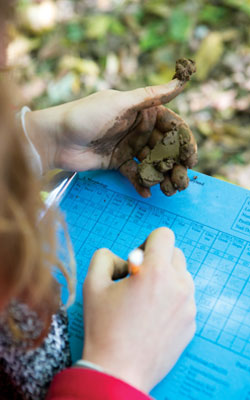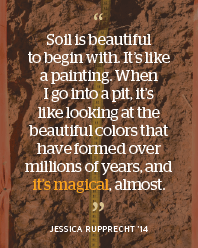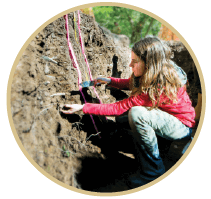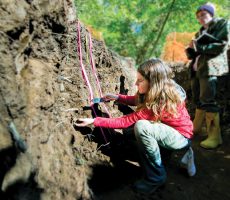- February 07, 2014
- By Lauren Brown
Jessica Rupprecht ’14 climbs out of a 5-feet-deep pit in the woods somewhere 10 miles south of Frederick, Md. She sits on an overturned five-gallon pail, running a chunk of soil between her fingers. She presses it between her thumb and forefinger. She spritzes it with water. She scribbles on her scorecard, a small smile on her face.
 This is the Northeast Regional Collegiate Soil Contest, and it’s the most unlikely Friday you never had at Maryland.
This is the Northeast Regional Collegiate Soil Contest, and it’s the most unlikely Friday you never had at Maryland.
To most of us, what we plant in and build on is dirt. To a tiny subgroup of avid environmental science students such as Rupprecht, it’s soil. And it tells a complex, fascinating story.
Seven undergraduates make up Maryland’s soil-judging team, which in May will defend its third national title; it won the rightto return to nationals after placing second at the regional contest in October.
“Soil is beautiful to begin with,” says Rupprecht (left). “It’s like a painting. When I go into a pit, it’s like looking at the beautiful colors that have formed over millions of years, and it’s magical, almost.”
During soil judging, students examine, describe and interpret the soil profiles and landscapes at a variety of sites. They have to identify the different horizons, or layers, which can be subtle or striking, and then they describe their properties: color, texture, structure and wetness.
The soils are the product of tens of thousands of years of biological, chemical and physical processes. One horizon in a pit might be made up of a deposit caused by a landslide 15,000 years ago. Another near the surface might have been created by soil discarded during road construction 50 years ago.
Then the students have to determine appropriate uses for the soil, based on the U.S. Department of Agriculture’s (USDA’s) classification scale. Is this a good place to dig a basement? Place a wastewater system? Start a farm?
 “It’s a tremendous educational experience,” says Professor Martin Rabenhorst ’75, who alternates coaching the UMD team annually with Professor Brian Needelman. “They get to travel around the region or the country and see this vast array of soils. They develop these wonderful field skills that make them highly marketable.”
“It’s a tremendous educational experience,” says Professor Martin Rabenhorst ’75, who alternates coaching the UMD team annually with Professor Brian Needelman. “They get to travel around the region or the country and see this vast array of soils. They develop these wonderful field skills that make them highly marketable.”
Nobody goes to college to study soils, Rabenhorst admits. He didn’t. He came to Maryland for conservation, and maybe to become a forest ranger. Like many of the students he’s coached in the last 30 years, he stumbled onto soil judging.
 “I went out to a practice on a Saturday, and they threw me in a hole before I even knew what this was,” he says. Turns out he had an eye for it, and his team won the 1972 national competition.
“I went out to a practice on a Saturday, and they threw me in a hole before I even knew what this was,” he says. Turns out he had an eye for it, and his team won the 1972 national competition.
Today, environmental science and technology majors are required to take an introductory soil science course, and that reels a few judgers in each year.
“I like the real-world application, the experience of it,” says Tyler Witowski, who graduated in December. “It’s hands-on rather than in the classroom, droning over lectures and looking at pictures. The team aspect is great, too.”
He wore a teal, faux-fur Russian hat to the regionals. His teammate, Sara Mack ’14, donned a Viking-style horned helmet. Nearly everyone was bundled up in Carhartts and hoodies. And every competitor’s pants were caked with dirt. Er, soil.
The family of former soil judger Mark Matovich ’12 welcomed the students from colleges from Rhode Island to Ohio to their farm, but the event was an unofficial UMD soil judging reunion. Graduate students, USDA and state conservation officials, soil scientists and consultants all came out to serve as pit monitors, advisers and scorecard judges and even to manually pump out pits flooded by rainwater the previous week.
 For three days, the students practiced in pits all across Western Maryland before hopping into the competition ones, freshly dug by a backhoe on the 150-acre property. The contest itself was oddly silent, except for the rustling of leaves, squawking of birds and scraping of knives and shovels in the pits.
For three days, the students practiced in pits all across Western Maryland before hopping into the competition ones, freshly dug by a backhoe on the 150-acre property. The contest itself was oddly silent, except for the rustling of leaves, squawking of birds and scraping of knives and shovels in the pits.
Victory loosened things up. The UMD team members broke out in a sort of twirling dance when they learned they’d qualified for nationals. That was nothing compared to their reaction after winning it all last year. They drove all night from Wisconsin, arrived home as Maryland Day was in full swing, and began an impromptu parade across campus with their 3-feet-tall (and exceptionally heavy) trophy.
“Really, it’s not about winning. But when you have this intense and fun and transformative experience with these students, and then you come back and have to say, we came in fifth, it doesn’t capture it,” Needelman says. “As anticlimactic as it is to say that, it’s the opposite to say we won.”
